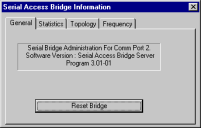
Many of Symbol Technologies’ Serial Access Bridges (SABs), such as the SAB II, provide support for Bridge Access Routines (BARs). These BAR commands provide direct access to SAB features. For example, using BAR commands, you can remotely reset an SAB or alter its communication frequencies.
Symbol Technologies’ SAB-Lite does NOT support BAR commands. The Wavelink Administrator’s BAR commands will not function when using SAB-Lite.
To access the BAR command options for a BAR‑compliant SAB, right-click the SAB’s serial Port Monitor and select Bridge Access Routines from the context menu.
A dialog box appears, containing four tabs: General, Statistics, Topology, and Frequency.
The General tab displays the software version of the SAB and the serial port to which the SAB is connected. You can also reset the SAB from the General tab by clicking Reset Bridge.
The Statistics tab displays a variety of statistical information captured by the SAB.
See the documentation included with your SAB for more information on the statistics displayed in this tab.
You can also reset statistics values from the Statistics tab by clicking Reset Bridge Statistics.
The Topology tab provides a real-time hierarchical map of the mobile device connected to the SAB along with each device’s Unit ID.
The types of wireless devices that appear in the Topology tab are as follows:
• Pseudo-Base. Either the current SAB itself or a configuration cradle.
• Hardware Base. An active transceiver unit.
• Uninitialized Base. An uninitialized transceiver unit. These units include transceivers that are powered down, physically removed from the network, or restarting.
• On Air Remote. An active mobile device.
• Uninitialized Remote. An uninitialized mobile device. These terminals include devices that are powered down, physically removed from the network, restarting, or being reconfigured.
• In Cradle Remote. An mobile device that is placed within a configuration cradle but that is not currently being reconfigured.
To remove any devices from the Topology map, select the device you want to remove and press Delete.
The topology entries for both transceivers and mobile devices remain even after you remove devices from the network, or reconfigure them with a new unit ID. If you remove or reconfigure devices, be sure to manually remove the unit’s old entry from the topology map.
The Frequency tab displays the current frequencies the SAB uses.
The Remote Frequencies list displays the available frequencies in the local area that an SAB and a mobile device can use to communicate with each other. The frequency currently in use is highlighted.
The Base Frequencies list displays the available frequencies in the local area that a transceiver unit and SAB can use to communicate with each other. The frequency currently in use is highlighted.
To change either the remote or base frequencies, select the desired frequency from each list and click Set New Frequencies. The frequency change will take place immediately.
Was this article useful?
The topic was:
Inaccurate
Incomplete
Not what I expected
Other